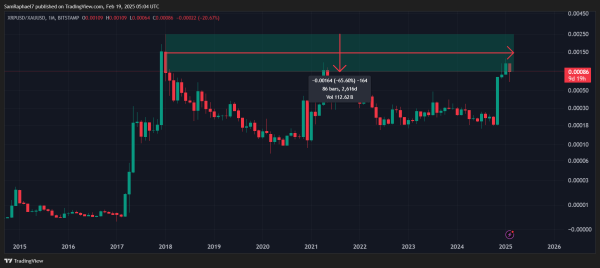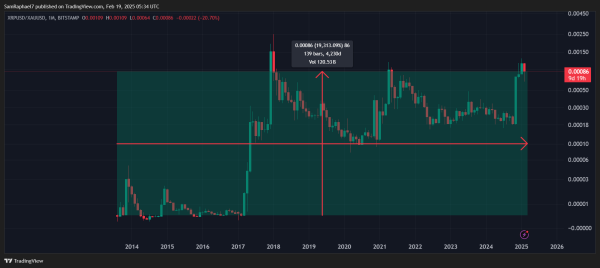ITC CEO Shows Gold Has Been a Better Investment Than XRP Since 2018, But Here are the Facts

The CEO of Into The Cryptoverse indicated that gold has been a better investment than XRP since 2018, but a broader assessment paints a different picture.
Notably, the evaluation came up as Peter Schiff, a well-known gold advocate and chief economist at Europac, reignited the discussion around gold and Bitcoin, as he and Bitcoin proponents continue to debate which is a better asset.
Bitcoin vs Gold Comparison
In his latest commentary, Schiff argued that anyone comparing the two does not understand gold. This statement led to a response from Into The Cryptoverse CEO, Benjamin Cowen, who highlighted Bitcoin’s growth compared to gold since Bitcoin’s launch 16 years ago.
100% agree!!!
Bitcoin has gone from $0 to $100k over the last 16 years while gold went from $2k to $3k
We are finding common ground after all this time ?
— Benjamin Cowen (@intocryptoverse) February 18, 2025
Cowen stressed that while Bitcoin surged from zero to $100,000 between 2009 and 2015, gold only moved from $2,000 to $3,000. His comments aimed to highlight Bitcoin’s superior returns, but they also sparked reactions from other crypto proponents, including an anonymous XRP enthusiast.
Interestingly, the XRP proponent countered Cowen’s claims by arguing that Bitcoin’s high volatility and repeated crashes prevent it from being a reliable store of value.
They also pointed out that gold, the U.S. dollar, and the euro hold Tier 1 asset classification by the Bank for International Settlements (BIS), whereas Bitcoin does not. Further, the XRP enthusiast claimed that in the coming years, XRP and gold would gain more recognition.
Gold Has Outperformed XRP Since 2018
In response, Cowen highlighted that XRP had lost 45% of its value against gold over the past seven years. This statement suggested that gold outperformed XRP within this timeframe, with Cowen humorously noting that even gold has been a better investment than XRP since 2018.
XRP is down 45% against GOLD over the last 7 years.
So even Gold was a better investment than XRP since 2018 ? pic.twitter.com/06r6DkmINg
— Benjamin Cowen (@intocryptoverse) February 18, 2025
However, in a more interesting twist, the reality is even more discouraging for XRP. Cowen’s assessment took into account XRP’s market capitalization relative to gold, which is not the most accurate way to measure price performance, as its increasing circulating supply also contributes to higher market caps.
When evaluating XRP’s actual price performance against gold, the XRPXAU trading pair tells a more bearish story. In early 2018, XRP’s peak value against gold stood at 0.00250. Today, it trades at around 0.00086, showing a more substantial 65% decline in value over the past seven years.

XRP Against Gold Since 2018
XRP Up 19,313% Against Gold Since Launch
However, Cowen’s evaluation does not fairly assess XRP’s performance, as it considered a time when XRP reached its peak. Looking at a broader scope, since its launch in August 2013, XRP has significantly outperformed gold.
At the time when XRP started trading in the open market, the XRPXAU pair stood at 0.000004430. By today’s value of 0.00086, XRP has surged by over 19,313%, proving that it has been a superior store of value over the long term.

XRP Against Gold Since 2013
Bitcoin, however, has seen even greater growth. The BTCXAU trading pair has skyrocketed by 43,743% within the same period. This indicates that while XRP outperformed gold over the past decade, Bitcoin outshined both assets by a much larger margin.
Meanwhile, some XRP enthusiasts attribute XRP’s underperformance since 2018 to regulatory challenges. The SEC’s lawsuit against Ripple, which began in December 2020, led to widespread delistings from major exchanges in the U.S. and Canada.
As a result, XRP missed out on the 2021 crypto bull run. Now, with regulatory clarity improving, XRP has begun recovering from years of price suppression. Despite nearly reclaiming its previous highs, it still has a long way to go to make up for the lost years.
 Bitcoin
Bitcoin  Ethereum
Ethereum  Tether
Tether  XRP
XRP  USDC
USDC  Solana
Solana  TRON
TRON  Lido Staked Ether
Lido Staked Ether  Dogecoin
Dogecoin  Figure Heloc
Figure Heloc  Cardano
Cardano  WhiteBIT Coin
WhiteBIT Coin  Bitcoin Cash
Bitcoin Cash  Wrapped stETH
Wrapped stETH  Wrapped Bitcoin
Wrapped Bitcoin  USDS
USDS  Wrapped eETH
Wrapped eETH  Binance Bridged USDT (BNB Smart Chain)
Binance Bridged USDT (BNB Smart Chain)  Chainlink
Chainlink  Monero
Monero  LEO Token
LEO Token  WETH
WETH  Zcash
Zcash  Stellar
Stellar  Hyperliquid
Hyperliquid  Coinbase Wrapped BTC
Coinbase Wrapped BTC  Ethena USDe
Ethena USDe  Litecoin
Litecoin  Sui
Sui  Avalanche
Avalanche  Hedera
Hedera  sUSDS
sUSDS  Shiba Inu
Shiba Inu  USDT0
USDT0  Dai
Dai  Uniswap
Uniswap  Canton
Canton  PayPal USD
PayPal USD  Mantle
Mantle  Cronos
Cronos  Toncoin
Toncoin  World Liberty Financial
World Liberty Financial  Ethena Staked USDe
Ethena Staked USDe  Polkadot
Polkadot  USD1
USD1  Aave
Aave  Rain
Rain  Bitget Token
Bitget Token  MemeCore
MemeCore  OKB
OKB  Tether Gold
Tether Gold  Falcon USD
Falcon USD  Bittensor
Bittensor  NEAR Protocol
NEAR Protocol  Ethereum Classic
Ethereum Classic  Binance-Peg WETH
Binance-Peg WETH  Jito Staked SOL
Jito Staked SOL  BlackRock USD Institutional Digital Liquidity Fund
BlackRock USD Institutional Digital Liquidity Fund  Pi Network
Pi Network  Internet Computer
Internet Computer  Aster
Aster  Pepe
Pepe  syrupUSDC
syrupUSDC  Ethena
Ethena  Midnight
Midnight  Jupiter Perpetuals Liquidity Provider Token
Jupiter Perpetuals Liquidity Provider Token  HTX DAO
HTX DAO  PAX Gold
PAX Gold  Global Dollar
Global Dollar  Sky
Sky  Circle USYC
Circle USYC  KuCoin
KuCoin  Ripple USD
Ripple USD  BFUSD
BFUSD  Binance Bridged USDC (BNB Smart Chain)
Binance Bridged USDC (BNB Smart Chain)  Worldcoin
Worldcoin  syrupUSDT
syrupUSDT  Ondo
Ondo  Rocket Pool ETH
Rocket Pool ETH  Aptos
Aptos  Gate
Gate  Binance Staked SOL
Binance Staked SOL  Wrapped BNB
Wrapped BNB  Pump.fun
Pump.fun  POL (ex-MATIC)
POL (ex-MATIC)  Quant
Quant  Arbitrum
Arbitrum  Official Trump
Official Trump  Algorand
Algorand  Function FBTC
Function FBTC  Lombard Staked BTC
Lombard Staked BTC  Solv Protocol BTC
Solv Protocol BTC  Filecoin
Filecoin  Cosmos Hub
Cosmos Hub  NEXO
NEXO  VeChain
VeChain  Liquid Staked ETH
Liquid Staked ETH  USDtb
USDtb  Superstate Short Duration U.S. Government Securities Fund (USTB)
Superstate Short Duration U.S. Government Securities Fund (USTB)  OUSG
OUSG  USDD
USDD  WrappedM by M^0
WrappedM by M^0  Janus Henderson Anemoy AAA CLO Fund
Janus Henderson Anemoy AAA CLO Fund  Beldex
Beldex  Sei
Sei  Mantle Staked Ether
Mantle Staked Ether  Arbitrum Bridged WBTC (Arbitrum One)
Arbitrum Bridged WBTC (Arbitrum One)  Polygon Bridged USDC (Polygon PoS)
Polygon Bridged USDC (Polygon PoS)  Ondo US Dollar Yield
Ondo US Dollar Yield  clBTC
clBTC  Bonk
Bonk  Render
Render  Renzo Restaked ETH
Renzo Restaked ETH  USDai
USDai  Wrapped Flare
Wrapped Flare  Polygon PoS Bridged DAI (Polygon POS)
Polygon PoS Bridged DAI (Polygon POS)  Kinetiq Staked HYPE
Kinetiq Staked HYPE  PancakeSwap
PancakeSwap  Jupiter
Jupiter  L2 Standard Bridged WETH (Base)
L2 Standard Bridged WETH (Base)  Jupiter Staked SOL
Jupiter Staked SOL  StakeWise Staked ETH
StakeWise Staked ETH  Pudgy Penguins
Pudgy Penguins  MYX Finance
MYX Finance  Story
Story  Usual USD
Usual USD  Optimism
Optimism  tBTC
tBTC  Bridged Wrapped Ether (Pundi AIFX Omnilayer)
Bridged Wrapped Ether (Pundi AIFX Omnilayer)  Arbitrum Bridged WETH (Arbitrum One)
Arbitrum Bridged WETH (Arbitrum One)  Curve DAO
Curve DAO  Dash
Dash  Spiko EU T-Bills Money Market Fund
Spiko EU T-Bills Money Market Fund  GHO
GHO  TrueUSD
TrueUSD  Artificial Superintelligence Alliance
Artificial Superintelligence Alliance  Lido DAO
Lido DAO  Ether.fi
Ether.fi  Merlin Chain
Merlin Chain  Tezos
Tezos  GTETH
GTETH  Virtuals Protocol
Virtuals Protocol  Injective
Injective  Aerodrome Finance
Aerodrome Finance  Stacks
Stacks  AB
AB  SPX6900
SPX6900  pippin
pippin  Stader ETHx
Stader ETHx  Ether.Fi Liquid ETH
Ether.Fi Liquid ETH  Marinade Staked SOL
Marinade Staked SOL  Wrapped ApeCoin
Wrapped ApeCoin  Celestia
Celestia  Starknet
Starknet  Swell Ethereum
Swell Ethereum  The Graph
The Graph  Audiera
Audiera  FLOKI
FLOKI  JUST
JUST  sBTC
sBTC  Chiliz
Chiliz  BitTorrent
BitTorrent  Lorenzo Wrapped Bitcoin
Lorenzo Wrapped Bitcoin  Sun Token
Sun Token  Steakhouse USDC Morpho Vault
Steakhouse USDC Morpho Vault  Coinbase Wrapped Staked ETH
Coinbase Wrapped Staked ETH  DoubleZero
DoubleZero  IOTA
IOTA  Maple Finance
Maple Finance  Conflux
Conflux  Bitcoin SV
Bitcoin SV  Ethereum Name Service
Ethereum Name Service  Telcoin
Telcoin  Olympus
Olympus  Avalanche Bridged BTC (Avalanche)
Avalanche Bridged BTC (Avalanche)  Kaia
Kaia  Trust Wallet
Trust Wallet  dogwifhat
dogwifhat  EURC
EURC  Pyth Network
Pyth Network  AINFT
AINFT  Binance-Peg Dogecoin
Binance-Peg Dogecoin  Cap USD
Cap USD  crvUSD
crvUSD  Resolv USR
Resolv USR  Kinesis Gold
Kinesis Gold  Resolv wstUSR
Resolv wstUSR  Gnosis
Gnosis 